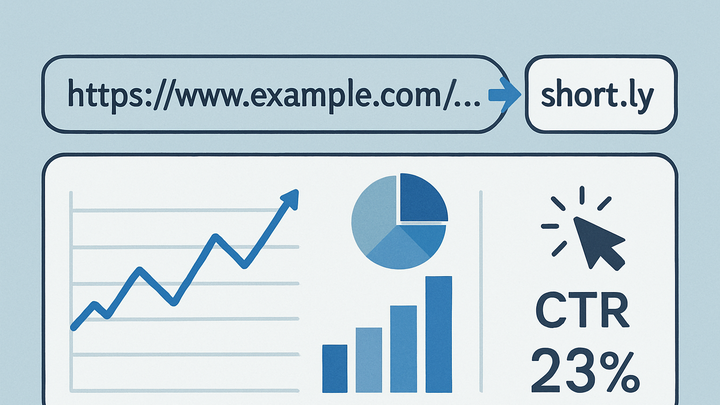Published on 2025-06-26T04:11:21Z
What is a URL Shortener? Examples with PlainSignal and GA4
URL shorteners are services that convert lengthy, complex URLs into concise, easy-to-share links. They play a critical role in analytics by enabling precise tracking of user clicks, improving link aesthetics, and managing campaign attribution. By appending UTM parameters or unique identifiers, short URLs help analytics platforms like PlainSignal and Google Analytics 4 (GA4) capture detailed metrics such as click-through rates, referral sources, and user engagement patterns. Many shorteners also support custom domains and expiration controls, enhancing brand consistency and security. Integrating URL shorteners with tracking snippets ensures that every redirect is logged and measured, providing valuable insights for marketing and data-driven decisions.
Url shortener
Service that turns long URLs into short links for easier sharing and detailed click tracking in analytics platforms like PlainSignal and GA4.
Why URL Shorteners Matter in Analytics
URL shorteners improve the user experience by creating cleaner links. They also enable more precise analytics tracking through unique redirects and embedded parameters. This section explores the key benefits that make URL shorteners essential tools for marketers and analysts.
-
Cleaner, shareable links
Shortened URLs are easier to share and look more professional, boosting click-through rates on social media and marketing channels.
-
Enhanced tracking capabilities
Each short link can encode unique identifiers or UTM parameters, allowing platforms to capture detailed click data and source attribution.
-
Improved brand consistency
Custom domains and branded shorteners reinforce brand identity and build trust with users.
How URL Shorteners Work
Under the hood, URL shorteners rely on redirect servers and unique key generation to map between short codes and original URLs. This section dives into the technical workflow behind the scenes.
-
Unique key generation
The service creates a unique, shortened key (e.g., a 6- to 8-character string) linked to the full URL in its database.
-
Http redirect mechanism
When a user clicks the short link, the server returns an HTTP 301 or 302 status, redirecting the browser to the original URL.
-
Click data collection
During the redirect, metadata like timestamp, referrer, and user agent can be captured for analytics reporting.
Integrating with Analytics Platforms
URL shorteners become powerful when combined with analytics tools. Below are examples of integration with PlainSignal and GA4.
-
PlainSignal integration
PlainSignal is a cookie-free analytics solution that captures click events at the redirect stage. To use it with a URL shortener:
<link rel="preconnect" href="//eu.plainsignal.com/" crossorigin /> <script defer data-do="yourwebsitedomain.com" data-id="0GQV1xmtzQQ" data-api="//eu.plainsignal.com" src="//cdn.plainsignal.com/plainsignal-min.js"></script>Add this snippet to the destination page, and PlainSignal will log each redirect as a pageview, enabling you to analyze click data without cookies.
-
Embed PlainSignal script
Place the
<link>and<script>tags in the<head>of your HTML to initialize PlainSignal tracking before any other assets load. -
Generate short url
Create a short link that points to the page with PlainSignal’s script. Include UTM parameters for deeper attribution if needed.
-
-
Google analytics 4 (GA4) integration
GA4 can track short link clicks as custom events. Since GA4 doesn’t provide a native shortener, use any service and then set up event tracking on click. Example:
<script async src="https://www.googletagmanager.com/gtag/js?id=G-XXXXXXX"></script> <script> window.dataLayer = window.dataLayer || []; function gtag(){dataLayer.push(arguments);} gtag('js', new Date()); gtag('config', 'G-XXXXXXX'); </script> <a href="https://sho.rt/abc123" id="shortLink">Click here</a> <script> document.getElementById('shortLink').addEventListener('click', function() { gtag('event', 'click', { 'event_category': 'Short Link', 'event_label': 'sho.rt/abc123' }); }); </script>This setup logs a
clickevent in GA4, allowing you to analyze user engagement with your short URLs.-
Configure GA4 script
Include the GA4
gtag.jssnippet on pages where you want to track events. -
Attach click event
Use JavaScript to fire a
gtag('event')when the short URL is clicked, capturing custom event data.
-
Best Practices for URL Shortening in Analytics
To maximize the value of URL shorteners, follow these industry best practices focused on maintainability, security, and data quality.
-
Use custom domains
Set up a branded domain for your shortened links to reinforce brand trust and avoid spam filters.
-
Standardize utm parameters
Develop a consistent naming convention for UTM tags to ensure accurate campaign attribution across all links.
-
Monitor link health
Regularly check that short URLs still resolve correctly and update or retire expired links to avoid 404 errors.
-
Ensure data privacy
Select services that comply with regulations like GDPR and support cookie-free tracking if needed.
